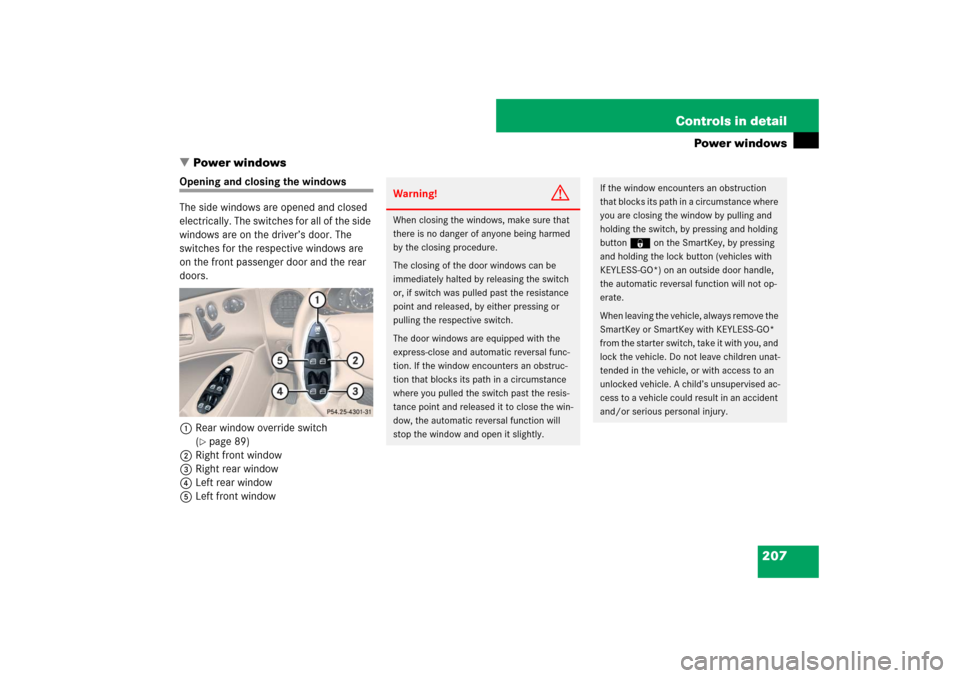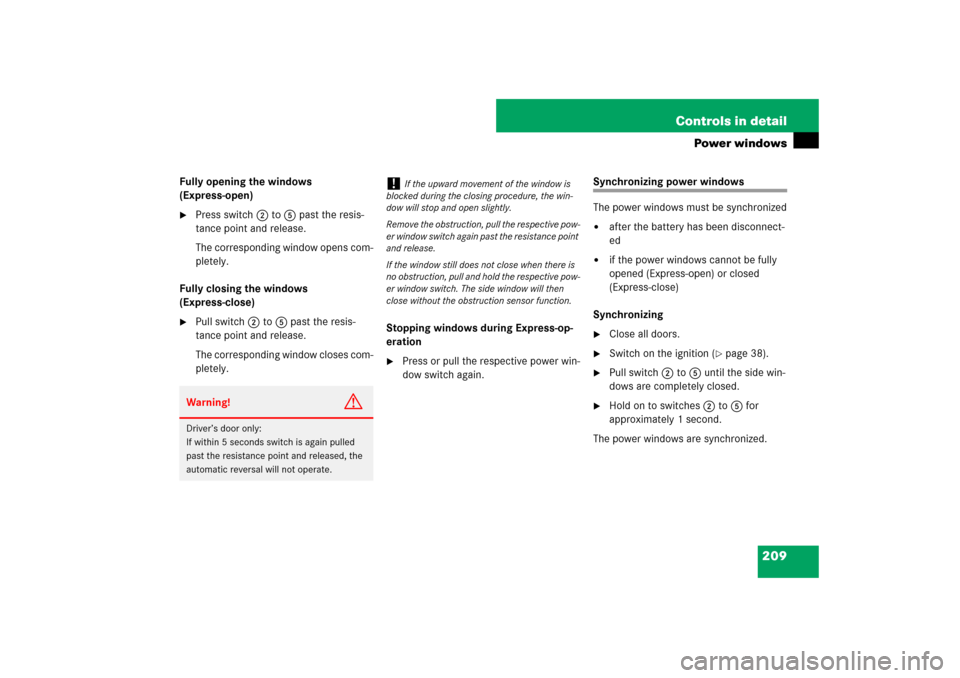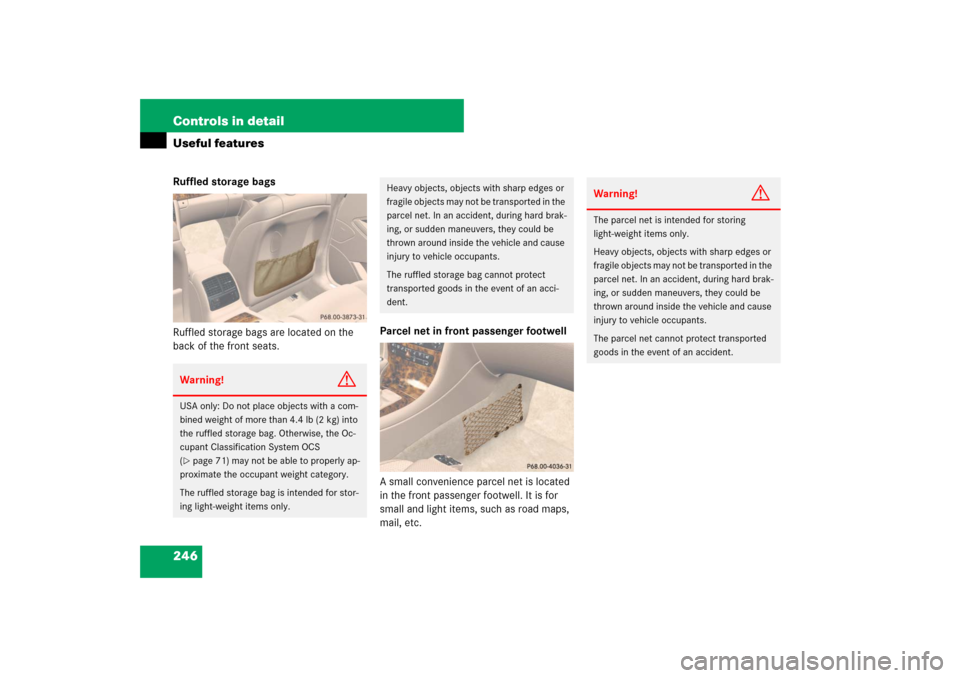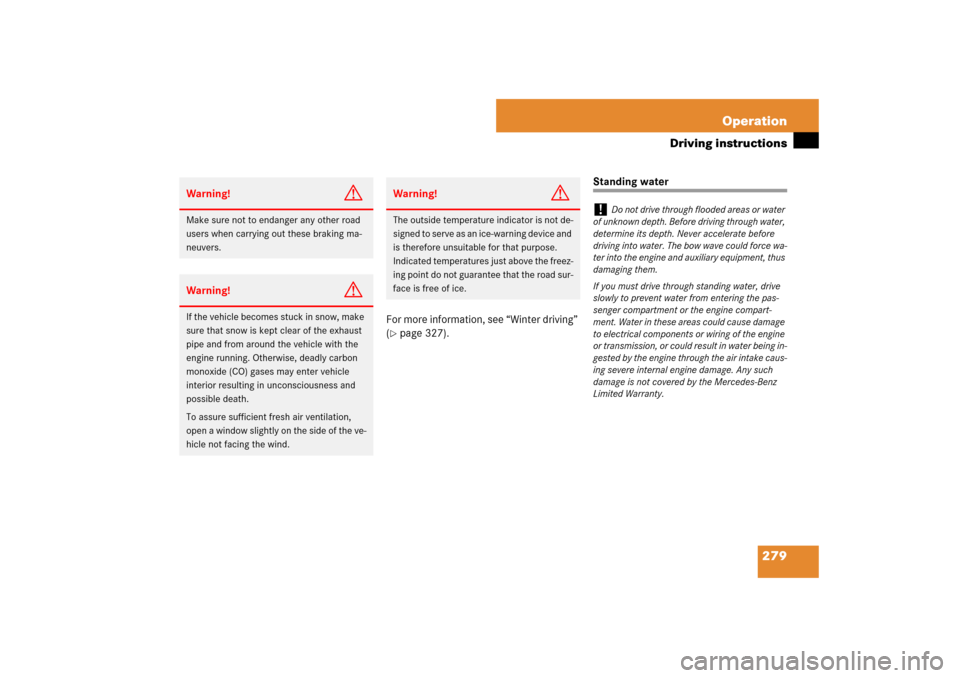Page 176 of 481

175 Controls in detail
Automatic transmission
Driving tips
Accelerator position
Your driving style influences the
transmission’s shifting behavior:
Less throttle Earlier upshifting
More throttle Later upshifting
Kickdown
Use kickdown when you want maximum
acceleration.�
Press the accelerator past the point of
resistance.
Depending on the engine speed the
transmission shifts into a lower gear.
�
Ease on the accelerator when you have
reached the desired speed.
The transmission shifts up again.Stopping
When you stop briefly, e.g. at traffic lights:
�
Leave the transmission in gear.
�
Hold the vehicle with the brake.
When you stop for a longer period of time
with the engine idling and/or on a hill:
�
Set the parking brake.
�
Move the gear selector lever to park
positionP.Maneuvering
When you maneuver in tight areas,
e.g. when pulling into a parking space:
�
Control the vehicle speed by gradually
releasing the brakes.
�
Accelerate gently.
�
Never abruptly step on the accelerator.
Working on the vehicleWarning!
G
When working on the vehicle, set the
parking brake and move gear selector lever
to park positionP. Otherwise the vehicle
could roll away.
Page 187 of 481

186 Controls in detailGood visibilityWarning!
G
The auto-dimming function does not react if
incoming light is not aimed directly at the
sensors in the interior rear view mirror.
The interior rear view mirror and the exterior
rear view mirror on the driver’s side do not
react, for example, if the rear window sun-
shade* is in raised position.
Light hitting the mirror(s) at certain angles
incident light) could blind you. As a result,
you may not be able to observe traffic con-
ditions and could cause an accident.
Warning!
G
In case of an accident, liquid electrolyte may
escape from the mirror housing if the mirror
glass breaks.
Electrolyte has an irritating effect. Do not
allow the liquid to come into contact with
eyes, skin, clothing, or respiratory system.
In case it does, immediately flush affected
area with water, and seek medical help if
necessary.!
Electrolyte drops coming into contact with
the vehicle paint finish can be completely re-
moved only while in the liquid state by applying
plenty of water.
Warning!
G
Exercise care when using the passen-
ger-side exterior rear view mirror. The mirror
surface is convex (outwardly curved surface
for a wider field of view). Objects in mirror
are closer than they appear. Check your in-
terior rear view mirror or glance over your
shoulder before changing lanes.
Page 189 of 481

188 Controls in detailGood visibility1Sun visor
2Mirror cover
3Mirror lamp
4Mounting
5Vanity mirror�
Swing sun visors1 down when you
experience glare.
�
To use the vanity mirror5, lift up the
mirror cover2.
Make sure the sun visor is properly
engaged in the mounting4.
Lamp3 switches on.If sunlight enters through a side window:
�
Disengage sun visor1 from
mounting4.
�
Pivot sun visor to the side.
Rear window sunshade*
The switch is located in the center console.
1Rear window sunshade switch
�
Switch on the ignition (
�page 38).
�
Press switch1 briefly to raise the sun-
shade.
�
Press switch1 briefly to lower the
sunshade.
Always raise the sunshade fully for its sup-
port against the window frame.
i
If sun visor1 is disengaged from
mounting4 with mirror cover2 open, mirror
lamp3 will switch off.
Warning!
G
When operating the rear window sunshade,
be sure that there is no danger of anyone
being harmed by the raising or lowering pro-
cedure.
The raising or lowering procedure can be
immediately halted by briefly pressing
switch1. To reverse direction of move-
ment, press switch1 again.
Page 208 of 481

207 Controls in detail
Power windows
�Power windows
Opening and closing the windows
The side windows are opened and closed
electrically. The switches for all of the side
windows are on the driver’s door. The
switches for the respective windows are
on the front passenger door and the rear
doors.
1Rear window override switch
(
�page 89)
2Right front window
3Right rear window
4Left rear window
5Left front window
Warning!
G
When closing the windows, make sure that
there is no danger of anyone being harmed
by the closing procedure.
The closing of the door windows can be
immediately halted by releasing the switch
or, if switch was pulled past the resistance
point and released, by either pressing or
pulling the respective switch.
The door windows are equipped with the
express-close and automatic reversal func-
tion. If the window encounters an obstruc-
tion that blocks its path in a circumstance
where you pulled the switch past the resis-
tance point and released it to close the win-
dow, the automatic reversal function will
stop the window and open it slightly.
If the window encounters an obstruction
that blocks its path in a circumstance where
you are closing the window by pulling and
holding the switch, by pressing and holding
button‹ on the SmartKey, by pressing
and holding the lock button (vehicles with
KEYLESS-GO*) on an outside door handle,
the automatic reversal function will not op-
erate.
When leaving the vehicle, always remove the
SmartKey or SmartKey with KEYLESS-GO*
from the starter switch, take it with you, and
lock the vehicle. Do not leave children unat-
tended in the vehicle, or with access to an
unlocked vehicle. A child’s unsupervised ac-
cess to a vehicle could result in an accident
and/or serious personal injury.
Page 210 of 481

209 Controls in detail
Power windows
Fully opening the windows
(Express-open)�
Press switch2 to 5 past the resis-
tance point and release.
The corresponding window opens com-
pletely.
Fully closing the windows
(Express-close)
�
Pull switch2 to 5 past the resis-
tance point and release.
The corresponding window closes com-
pletely.Stopping windows during Express-op-
eration
�
Press or pull the respective power win-
dow switch again.
Synchronizing power windows
The power windows must be synchronized�
after the battery has been disconnect-
ed
�
if the power windows cannot be fully
opened (Express-open) or closed
(Express-close)
Synchronizing
�
Close all doors.
�
Switch on the ignition (
�page 38).
�
Pull switch2 to 5 until the side win-
dows are completely closed.
�
Hold on to switches2 to 5 for
approximately 1 second.
The power windows are synchronized.
Warning!
G
Driver’s door only:
If within 5 seconds switch is again pulled
past the resistance point and released, the
automatic reversal will not operate.
!
If the upward movement of the window is
blocked during the closing procedure, the win-
dow will stop and open slightly.
Remove the obstruction, pull the respective pow-
er window switch again past the resistance point
and release.
If the window still does not close when there is
no obstruction, pull and hold the respective pow-
er window switch. The side window will then
close without the obstruction sensor function.
Page 247 of 481

246 Controls in detailUseful featuresRuffled storage bags
Ruffled storage bags are located on the
back of the front seats.Parcel net in front passenger footwell
A small convenience parcel net is located
in the front passenger footwell. It is for
small and light items, such as road maps,
mail, etc.Warning!
G
USA only: Do not place objects with a com-
bined weight of more than 4.4 lb (2 kg) into
the ruffled storage bag. Otherwise, the Oc-
cupant Classification System OCS
(�page 71) may not be able to properly ap-
proximate the occupant weight category.
The ruffled storage bag is intended for stor-
ing light-weight items only.
Heavy objects, objects with sharp edges or
fragile objects may not be transported in the
parcel net. In an accident, during hard brak-
ing, or sudden maneuvers, they could be
thrown around inside the vehicle and cause
injury to vehicle occupants.
The ruffled storage bag cannot protect
transported goods in the event of an acci-
dent.
Warning!
G
The parcel net is intended for storing
light-weight items only.
Heavy objects, objects with sharp edges or
fragile objects may not be transported in the
parcel net. In an accident, during hard brak-
ing, or sudden maneuvers, they could be
thrown around inside the vehicle and cause
injury to vehicle occupants.
The parcel net cannot protect transported
goods in the event of an accident.
Page 251 of 481

250 Controls in detailUseful featuresReinstalling ashtray insert�
Install insert by pushing it back into
frame until it engages again.
Rear door ashtray
1Sliding button
2Insert slides out
3AshtrayOpening rear seat ashtray
�
Briefly press the top of ashtray3.
The ashtray opens.
Removing ashtray insert
�
Push sliding button1 and remove
insert2 upwards from ashtray frame.
Reinstalling ashtray insert
�
Install insert by pushing it back into
ashtray frame until it engages again.
Cigarette lighterWarning!
G
Never touch the heating element or sides of
the lighter; they are extremely hot. Hold the
knob only.
Make sure that any children traveling with
you do not injure themselves or start a fire
with the hot cigarette lighter.
When leaving the vehicle, always remove the
SmartKey or the SmartKey with
KEYLESS-GO* from the starter switch, take
it with you, and lock the vehicle. Do not
leave children unattended in the vehicle, or
with access to an unlocked vehicle. A child’s
unsupervised access to a vehicle could re-
sult in an accident and/or serious personal
injury.
Page 280 of 481

279 Operation
Driving instructions
For more information, see “Winter driving”
(�page 327).
Standing water
Warning!
G
Make sure not to endanger any other road
users when carrying out these braking ma-
neuvers.Warning!
G
If the vehicle becomes stuck in snow, make
sure that snow is kept clear of the exhaust
pipe and from around the vehicle with the
engine running. Otherwise, deadly carbon
monoxide (CO) gases may enter vehicle
interior resulting in unconsciousness and
possible death.
To assure sufficient fresh air ventilation,
open a window slightly on the side of the ve-
hicle not facing the wind.
Warning!
G
The outside temperature indicator is not de-
signed to serve as an ice-warning device and
is therefore unsuitable for that purpose.
Indicated temperatures just above the freez-
ing point do not guarantee that the road sur-
face is free of ice.
!
Do not drive through flooded areas or water
of unknown depth. Before driving through water,
determine its depth. Never accelerate before
driving into water. The bow wave could force wa-
ter into the engine and auxiliary equipment, thus
damaging them.
If you must drive through standing water, drive
slowly to prevent water from entering the pas-
senger compartment or the engine compart-
ment. Water in these areas could cause damage
to electrical components or wiring of the engine
or transmission, or could result in water being in-
gested by the engine through the air intake caus-
ing severe internal engine damage. Any such
damage is not covered by the Mercedes-Benz
Limited Warranty.